

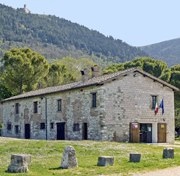
The Antiquarium, which is in a medieval house in Via del Teatro Romano, also serves as the ticket office for the surrounding "percorso archeologico". This signed itinerary includes:
-
✴the Antiquarium itself (which stands above the excavations of a Roman domus known as the Domus of Scylla - see below);
-
✴the Roman theatre, which is the star attraction;
-
✴the mausoleum of Lucius Pomponius Grecinus; and
-
✴the wider archeological area of la Guastuglia, which extends across some 25 acres bounded by Viale del Teatro Romano, Via Matteotti, Viale Parruccini, Via Ubaldi and Via Perugina.
The antiquarium exhibits material from the excavations that have been carried out in this area in 2001-10 and from earlier excavations in other locations in and around Gubbio.
Area around the Percorso Archeologico
Domus of Scylla (1st century BC)
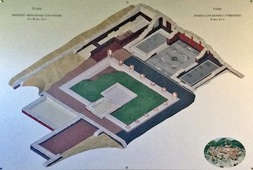
Excavations in 1985 under the medieval house that now houses the antiquarium unearthed part of this large domus. More specifically, four rooms were unearthed, arranged around a peristyle. Three of the rooms had black and white mosaic pavements, the dating of which suggests that the domus had remained in use until at least the 2nd century AD.
Mosaic of Scylla and Odysseus (2nd century BC)
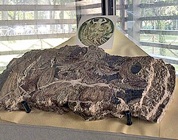
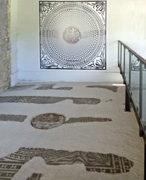
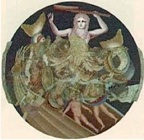
The name given to the domus records the mosaic at the centre of the floor of the largest of these rooms, which depicts the legend of Scylla and Odysseus. In Greek myth, Scylla was a beautiful water nymph who was turned into a monster by a jealous wife (variously identified as Amphitrire, the wife of Poseidon or Circe, the lover of Glaucus). She and another monster called Charybides kept guard on opposite sides of the narrow the Strait of Messina, between Sicily and peninsular Italy. In Homer's “Odyssey”, Circe advised Odysseus to sail closer to Scylla than to Charybides , and to distract her by casting six seamen overboard so that the boat and the rest of the crew could survive.
This is the scene that is depicted in this mosaic, which is considerably older than the rest of the composition. It was originally circular, but only its central section survives. The museum exhibits a reconstruction of the entire scene. On the left, Odysseus stands in the stern of his ship, preparing to throw his spear as Scylla raises a club above the floundering vessel. His terrified helmsman stands behind him, and three of the six sacrificed crewmen are attacked by dog-headed tentacles below.
Area of the Roman Theatre

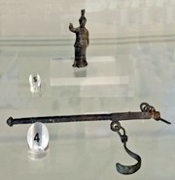
The following were found during excavations carried out near the Roman Theatre in 1969-70:
-
✴from the pre-Roman period:
-
•a bronze votive offering (5th or 4th century BC) in the form of a female figure [7]; and
-
✴from the Roman period:
-
•a small bronze statue of Minerva (1st century AD) [5];
-
•a bronze weighing balance (1st century AD) [4].
Area inside Porta degli Ortacci
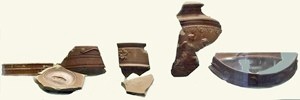
The area inside Porta degli Ortacci was excavated in ca. 1749, just prior to the construction of the Ospedale Grande. Further excavation was possible for a short period during roadwork in Via degli Ortacci in 1928, and more systematic excavations were carried out here in the 1980s. Finds made at the lower levels included:
-
✴the remains of many rooms from a building that probably formed part of the Roman baths (1st century BC); and
-
✴a broadly contemporary domus.
These sturcture marked the first stages of the expansion of the city into the plain to the south in the 2nd century BC, as the Romans began the construction of the city of Iguvium.
Some ceramics (late 1st century BC and early 1st century AD) found here are exhibited in the Antiquarium. These are mostly domestic items (cups, bowls, plates), and they display the signatures of a wide variety of local workshops,.
Finds from the Temple (1st century AD)
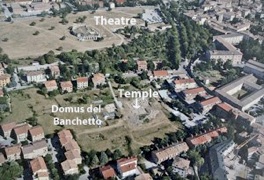
Aerial photograph showing the location of the temple
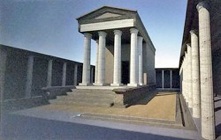
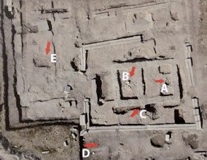
Reconstruction of the temple Votive deposits on the site (marked A-E)
All three illustrations are displayed in the Antiquarium
The foundations of this temple (see the page "percorso archeologico") were discovered during excavations in 2001-10. It comprised a cella and pronaus on a podium (7.4 x 11.5 meters), facing southeast. Only the foundations (including those of the base of a statue at the centre of its back wall) and the remains of the podium survive.
A votive deposit in front of this statue (at A in the plan above), which was sealed by a double layer of stones and bricks, seems to have been used for animal sacrifice. According to the notes displayed in the Antiquarium, this sacrifice probably took place in the 1st century AD, at the time of the consecration of the temple. Four nearby pits also contained evidence of the sacrifice of animals: again according to the notes displayed in the Antiquarium, these sacrifices were associated with the abandonment of the sanctuary in the 4th century AD.
Head of a Panther
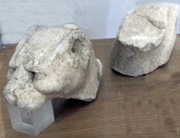
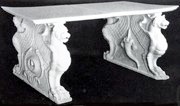
This head of a panther would have decorated a table of some kind, as suggested by the reconstruction illustrated provided by the Antiquarium (as in the photograph above, to the right).
Other Finds from the Temple Area
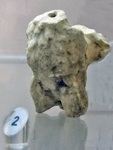
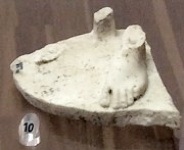
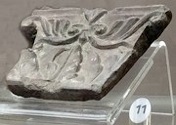
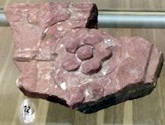
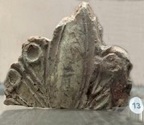
These include:
-
✴a fragment (1st century AD) of a marble statue of a bird of prey [2];
-
✴a foot (1st century AD) from a small marble statue of a man [10];
-
✴coins from the reigns of (respectively):
-
•the Emperor Marcus Aurelius (161-80 AD),
-
•the Emperor Philip the Arab (Marcus Julius Philippus, 244-9 AD); and
-
•the Emperor Trajan Decius (249-51 AD), not illustrated;
-
✴fragment (1st century AD) of two red marble capitals [11 and 12]; and
-
✴a fragment (early 1st century AD) of a palmate antefix [13].
Axe Head (1st century AD)
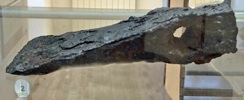
This iron axe head, which was found in pit A, would have been used during the ritual slaughter of animals.
Finds from Pit E
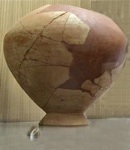
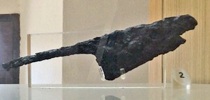
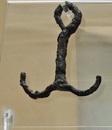
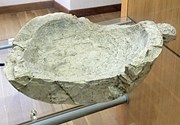

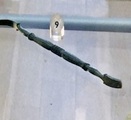
Evidence for animal sacrifice from this pit includes:
-
✴the lower part of a ceramic vase used for libations [1];
-
✴an iron knife (ca. 300 AD) [2];
-
✴a double hook (ca. 300 AD) for hanging carcasses [3];
-
✴a travertine bowl (2nd century AD) for holy water [4];
-
✴bone fragments from sacrificed animals; and
-
✴a bronze surgical instrument (1st century AD).
Roman Mosaic (1st century BC)
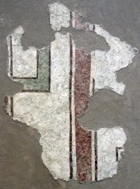
Roman Mosaics (ca. 300 AD)
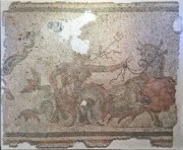
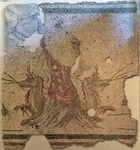
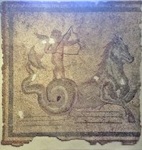
A polychrome mosaic pavement was discovered in 1912 and detached in the 1950s in an area of Guastuglia that can no longer be identified. Fragments of seven marine scenes that would have beed enclosed within friezes survive, the three most complete of which are depicted above. The mosaics probably originally decorated the floor of a thermal complex.
Other Finds from Guastuglia

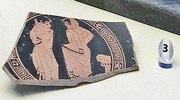


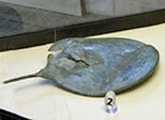
The following were found [in unspecified locations?] during excavations carried out in Guastuglia in 1972-4:
-
✴from the pre-Roman period:
-
•a pendant in the shape of a horse (ca. 500 BC) [5];
-
•a fragment of a kylix (shallow drinking cup) with red-figure figurative decoration (5th century BC) [3];
-
•a tiny bronze votive figure (ca. 400 BC) of a woman with an elaborate hairstyle, who seems to be dancing [7];
-
•a “semi-asse” (coin) inscribed “ikuvins”, which was probably minted locally in the 3rd century BC; and
-
•a bronze mirror (ca. 200 BC) [2]; and
-
✴from the Roman period:
-
•a terracotta antefix (2nd or 3rd century AD) depicting a cupid-like figure (illustrated here);
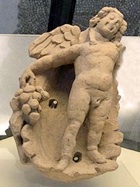
-
•a bronze seal (2nd or 3rd century AD) inscribed “IUSTISIS”;
-
•a bronze cylinder 2nd or 3rd century AD) [used in spinning??]; and
-
•two sestertii (coins) from the reigns of (respectively) the Emperor Antoninus Pius (138–61 AD) and the Emperor Caracalla (198–217 AD).
Wider area of Gubbio and its Surroundings
Necropolis near San Biagio
This necropolis near the church of San Biagio (see Walk II) was discovered [when?], Seven campaigns of excavation have unearthed some seventy tombs:
-
✴In the oldest part of the necropolis, the tombs (7th - 6th centuries BC) are arranged in three large circles.
-
✴The necropolis seems then to have been abandoned until the 4th century BC, when single graves appear. The most not-worthy grave goods from these tombs were the black-painted vases from tombs 1, 20, 21 and 22.
-
✴Similar graves from the 3rd-2nd centuries BC generally lack grave goods, except for seven graves of infants from the 2nd century BC that are grouped together in the south west part of the necropolis.
-
✴There necropolis was then occasionally used for the burial of relatively poor people in the Roman period.
Black-painted Vases (ca. 300 BC)
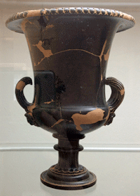
-
✴one from Tomb 20, illustrated here, and
-
✴one from Tomb 21.
These are examples of Malacena Ware, a highly-prized type of ceramic produced in Volterra, which was named for the examples that were discovered in 1893 in the tomb of the Calisna Sepu in the Casone Necropolis at Campo della Malacena, Monteriggioni (near Siena).
Finds from Tomb 18/97 (2nd century BC)
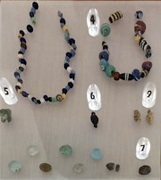
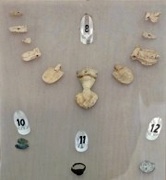
This tomb was one of the seven infant graves mentioned above, but is differentiated from them by the high quality of the gave goods. These include two necklaces made of glass beads and a number of other beads and bone pendants, together with four miniature vases (not illustrated). The coin [12] is a denarius (155 BC), with the head of a personification of Rome on one side and Victory driving a chariot on the other. It bears the signature of the moneyer Pinarius Natta, who made coins in Rome.
Necropolis near Santa Maria della Vittoria
The Vittorina necropolis extended along along the Via Vittorina a Roman road linking Gubbio to Via Flaminia, which probably followed the line of a much older road:
-
✴The main part of the necropolis was discovered in 1980 during earthworks for the construction of the new headquarters of a cement company, Collacem Spa (60 Vale Vittorina - see Walk II). Excavations in 1980-2 uncovered some 237 tombs, mostly from the period 1st century BC - 2nd century AD, which were spread out across an area that extended across Via Frate Lupo into the park in front of the church of Santa Maria della Vittoria.
-
•Some finds from this part of the necropolis are exhibited here.
-
•Others (from Tomb 221) are exhibited of the room in the Museo Archeologico, Perugia that I have labelled Roman Umbria I.
-
✴The ten much older graves were discovered in 1989 during the construction of a residence at the southern end of Via Gandhi (on the north west edge of the main necropolis). These were male inhumation graves, in each of which the deceased had a red-figured vases Attic vase at his feet:
-
•four of these vases are exhibited here;
-
•a column krater (425-400 BC) from a fifth tomb is exhibited in the Sala dei Bronzi of the Museo Archeologico, Perugia.
Attic Kraters (5th century BC)
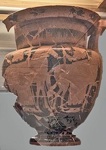
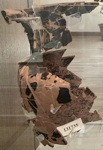
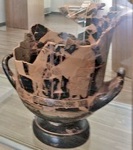
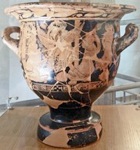
Inventory:
117218 131735 131736 117002
These red-figured kraters (vessels for mixing wine and water, which has been recomposed from fragments, came from the tombs that were excavated of 1989 (see above):
-
✴117218, a column krater (so-called because of its column-like handles), came from Tomb 1.
-
•The main side depicts two cloaked warriors on horseback.
-
•The other side depicts three cloaked men who are apparently in a discussion of some sort.
-
The vase is attributed to the Painter of Louvre Centauromachy, who was active in 450-430 BC.
-
✴131735 is a column krater from Tomb 3, of which only fragments survive. The surviving depictions of cloaked figures are too incomplete to be interpreted.
-
✴131736, a calyx krater (so-called because its lower body is shaped like the calyx of a flower) that was found near Tomb 3, dates to ca. 440 BC.
-
•The main side depicts a mounted Amazon fighting two Greek hoplites (soldiers fighting on foot).
-
•The other side depicts three cloaked men with sticks or lances.
-
✴117002, a bell krater came from Tomb 8 and probably dates to the late 5th century BC. It is of very high quality and must have belonged to a leading man in the developing urban community.
-
•The main side depicts Boreas carrying off Orithyia, the daughter of the King of Athens, and has a view of that city that is particularly interesting.
-
•The other side depicts three naked athletes.
Relief (early 1st century AD)
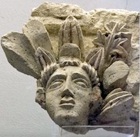
Grave Goods from the Tomb 65 (ca. 100 AD)
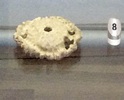
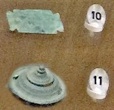
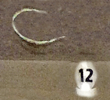

The goods from this grave are mostly quite ordinary objects, including:
-
✴a small bone yo-yo [8];
-
✴fittings from a wooden casket:
-
•a “tabula ansata” (plaque with handles), which does not seem to have been inscribed [10]; and
-
•a boss and one of its securing nails [11];
-
✴a part of a bronze wire bracelet [12]; and
-
✴a ceramic pitcher [13].
Grave Goods from the “Tomba di Iside” (early 2nd century AD)
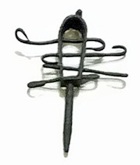
Cinerary Urn (2nd century AD
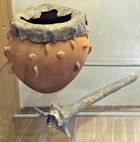
Other Necropoles in and around Gubbio
Via dei Consoli
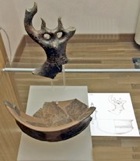
The excavations uncovered some 40 impasto (clay) lidded cinerary urns, one of which (from Tomb 17) is exhibited in the Museo Archeologico, Perugia. Other finds from this necropolis are exhibited in the Antiquarium, including these fragments from an impasto ossuary from Tomb 1.
Via Leonardo de Vinci
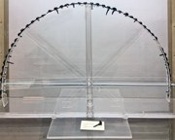
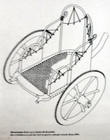
The so-called “Tomba del Carro” (tomb of the chariot) was discovered here in 1983. This simple ditch grave, which dated to the 6th century BC, had already been despoiled, but the remaining items included these iron fragments from the wheel of a parade chariot. The museum also exhibits this sketch of what the vehicle might have looked like.
Fontevole
This necropolis, which was discovered in 1982 during a housing development at Località Fontevole, west of Gubbio. This location could be the place called “Fontulis” that is mentioned in the Iguvine Tables, where three boars were sacrificed to Serfus Martius during the ritual purification of the army (described in Table VII). The oldest tombs, which are in the part of the necropolis nearest to the city, were in use in the 6th century BC
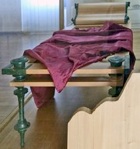
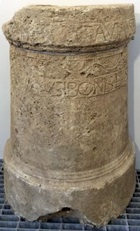
San Benedetto
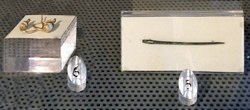
A necropolis of some 20 tombs near to the church of San Benedetto (see Walk II) was excavated in 1999. Most of the tombs belonged to relative poor people who were buried in the 1st century BC and the 1st century AD. The museum exhibits these grave goods (1st century BC) from a female grave (Tomb 17), which include earrings and a bronze needle.
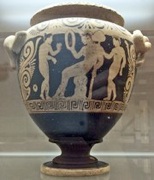
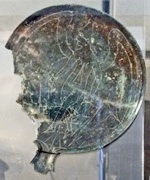
Signs that burials had occurred here sporadically in pre-Roman times include the following fortuitous finds from the area:
-
✴a red-figured stamnos (wine jug, 4th century BC) decorated with Dionysian scenes, including the seated Dionysus with a tambourine and thyrsus (staff of giant fennel covered with ivy ); and
-
✴a bronze mirror (2nd century BC) decorated by a winged figure in a conical hat who seems to be dancing.
Via Eraclito
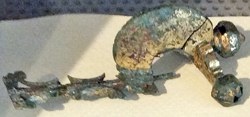
A necropolis of some 29 tombs in Via Eraclito (near san Benedetto) and a stretch of Roman road were excavated in 1997. (A similar stretch of road was found in nearby Via Epicuro in 2006.) The necropolis came into use in ca 100 AD and was used, albeit sporadically, into late antiquity. This gilded bronze fibula (5th century AD) from Tomb 25 attests to this late use of the necropolis.
Funerary Urn from Zappacenere (early 1st century AD)
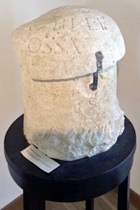
Portrait Busts (1st century AD)
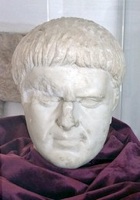
Read more:
L. Cencaioli et al., “Gubbio, la Domus di Scilla e il Parco Urbano: Uno Studio di Valorizzazione”, Bollettino di Archeologica Online, (2011)
S. Sisani, “Tuta Ikuvina: Sviluppo e Ideologia della Forma Urbana a Gubbio”, (2001) Rome
Return to the Museums in Gubbio.
Return to Walk II.

